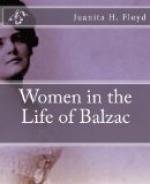Balzac knew several young girls at different periods of his life. His sister Laure was his first and only companion in his earlier years, and he knew his sister Laurence especially well in the years immediately preceding her marriage. Madame Carraud was a schoolmate of Madame Surville and visited in his home as a young girl. He was not only acquainted with the various daughters of Madame de Berny, but at one time there was some prospect of his marrying Julie. Josephine and Constance, daughters of Madame d’Abrantes, were acquaintances of his during their early womanhood. He must have known Mademoiselle de Trumilly as he presented himself as her suitor, and being entertained in her home frequently, doubtless saw her sisters also. Since he accompanied his sister to balls in his youth, it is natural to suppose that he met young girls there, even if there is no record of it.
A few years later he became devoted to the two daughters of his sister Laure, and lived with her for a short time. He knew Madame Hanska’s daughter Anna in her childhood, but was most intimate with her when she was about twenty. While Madame de Girardin was not so young, he met her several years before her marriage, called her Delphine, and regarded her somewhat as his pupil. He liked Marie de Montbeau and her mother, Camille Delannoy, who was a friend of his sister Laure and the daughter of the family friend, Madame Delannoy. Though not intimate with her, he met and observed Eugenie, the daughter of Madame de Bolognini at Milan, and probably was acquainted with Inez and Hyacinthe, the two daughters of Madame Desbordes-Valmore.
In his various works, he has portrayed quite a number of young girls varying greatly in rank and temperament, among the most prominent being Marguerite Claes (La Recherche de l’Absolu), noted for her ability and her strength of character, headstrong and much petted Emilie de Fontaine (Le Bal de Sceaux), Laurence de Cinq-Cygne, the very zealous Royalist (Une tenebreuse Affaire), romantic Modeste Mignon, pitiable Pierrette Lorrain, dutiful and devout Ursule Mirouet, unfortunate Fosseuse (Le Medecin de Campagne), bold and unhappy Rosalie de Watteville (Albert Savarus), and the well-known Eugenie Grandet.
The novelist has revealed to us that he modeled one of these heroines on a combination of the woman who later became his wife, and her cousin, a most charming woman. It is quite possible that some if not all of the other heroines would be found to have equally interesting sources, could they be discovered.
Concerning the much discussed question as to whether Balzac portrayed young girls well, M. Marcel Barriere remarks:




